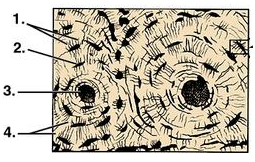The cell junctions in animal tissues that perform the function of cementing to keep neighbouring cells together are known as:
1. Tight junctions
2. Adhering junctions
3. Gap junctions
4. Desmosomes
1. Tight junctions
2. Adhering junctions
3. Gap junctions
4. Desmosomes
A sheath of connective tissue that encloses several bundles of muscle fibers in a skeletal muscle is called as:
| 1. | Epimysium | 2. | Perimysium |
| 3. | Endomysium | 4. | Aponeurosis |
Tendons and ligaments are examples of:
| 1. | Loose connective tissue |
| 2. | Dense irregular connective tissue |
| 3. | Dense regular connective tissue |
| 4. | Specialized connective tissue |
The inner lining of the trachea and large bronchi is covered by:
1. Pseudostartified epithelium
2. Ciliated cuboidal epithelium
3. Transitional epithelium
4. Squamous epithelium
Match each item in Column I with one in Column II and select the correct answer from the codes given:
|
COLUMN I |
COLUMN II |
||
|
A |
Holocrine gland |
a |
Pancreas |
|
B |
Merocrine gland |
b |
Mammary gland |
|
C |
Apocrine gland |
c |
Sebaceous gland |
Codes
| A | B | C | |
| 1. | a | b | c |
| 2. | c | b | a |
| 3. | c | a | b |
| 4. | a | c | b |
What are the structures labelled A, B, C and D respectively, in the given diagram?
| 1. | Mast cell, Fibroblast, Collagen, Macrophage |
| 2. | Mast cell, Dendritic cell, Collagen, Macrophage |
| 3. | Macrophage, Fibroblast, Elastin, Mast cell |
| 4. | Macrophage, Fibroblast, Collagen, Mast cell |
The moist surfaces of the buccal cavity, oesophagus and cornea are covered by:
1. Stratified squamous keratinized epithelium
2. Stratified squamous non keratinized epithelium
3. Transitional epithelium
4. Pseudostratified epithelium
What are the structures labeled A, B, C and D respectively in the given diagram?

| 1. | Dendrites, Soma, Axon, Terminal nerve endings |
| 2. | Dendrites, Soma, Cyton, Terminal nerve endings |
| 3. | Terminal nerve endings, Soma, Axon, Dendrites |
| 4. | Terminal nerve endings, Soma, Perikaryon, Dendrites |
What are the structures labeled 1, 2, 3 and 4 respectively in the given diagram?

1. Lamellae, Osteocyte, Haversian canal, Canaliculi
2. Lamellae, Osteocyte, Volkman’s canal, Canaliculi
3. Canaliculi, Osteocyte, Haversian canal, Lamellae
4. Canaliculi, Osteocyte, Volkman’s canal, Lamellae
Match each item in Column I [Type of cartilage] with one in Column II [Location] and select the correct answer from the codes given:
|
COLUMN I |
COLUMN II |
||
|
A |
Hyaline |
a |
Intervertebral discs |
|
B |
Fibrous |
b |
Pinna, epiglottis |
|
C |
Elastic |
c |
Sternum, hyoid, ribs |
Codes
A B C
1. a b c
2. c b a
3. c a b
4. a c b








